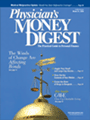Publication
Article
Physician's Money Digest
Consider TIPS over Money Market Funds
Author(s):
With money market fund yields close to0.5%, a lot of physician-investors arelooking for something different. Twoof the best options are short-termbonds and bond funds and Treasury inflation protectedsecurities (TIPS) because they offer higher yieldswith moderately higher risk. But before you chooseeither of these options, you should fully understandthe nature of this additional risk and the other characteristicsof these instruments.
Real and Nominal Rates
To understand TIPS, you first need to understandthe difference between nominal and real interest rates.Nominal interest rates are the interest rates physician-investorsdeal with most of the time. For example, ifyou buy a 5-year bank CD with a 5% annual interestrate, it's a nominal interest rate (ie, what you willreceive in dollars regardless of what the rate of inflationis over the period).
However, inflation reduces the buying power ofthe dollar. So if inflation averages 3% over the 5-yearperiod, you will actually earn a return of about 2%per year measured in buying power. This 2% is calledthe real or inflation-adjusted return.
TIPS Risk Assessment
The key difference between regular bonds andTIPS is that the returns on regular bonds are promisedin nominal interest rates, whereas the returns on TIPSare expressed in real interest rates.
TIPS are not perfect substitutes for money marketfunds, and you need to understand the risks of TIPS beforeinvesting in them as money market fund substitutes.
First, TIPS' prices will fluctuate with changes inreal interest rates. If real interest rates go up, yourTIPS will lose value. For example, a 0.5% increase inreal interest rates could reduce 10-year TIPS' prices byclose to 5%. But it is unknown just what makes realinterest rates change and what the appropriate realinterest rate is at any given time. When TIPS first cameon the market several years back, they were payingreal interest of around 4% per year. Now it's down toaround 1.7%. Based on long-term historical data, wemay guess that real interest rates should be in therange of 1.5% to 2.5%. If you buy 10-year TIPS nowand real interest rates go back to 3% or 4%, you willlose a lot of money, at least on paper.
Second, if you buy 10-year TIPS at today's rate ofabout 1.7% and are willing to hold on to them steadfastlyfor the next 10 years, you can expect twothings. You will earn a real return of 1.7% per yearand get your initial principal back.
Goals Realized
Finally, recognize that to retire and provide forother long-term needs, most of us need to shoot for along-term portfolio return of around 4% to 5%,although this may not be easy to achieve. By definition,any money you put in 10-year TIPS today willearn a real return of around 1.7% for that period. Soto get to that portfolio average of 4% to 5%, you willhave to earn an even higher real return on the rest ofyour portfolio—a rather challenging task. This shouldbe an important consideration in deciding how muchof your portfolio you invest in TIPS. You may be betteroff buying TIPS—preferably from the Treasury atthe quarterly auctions—instead of investing in a TIPSfund to avoid the fund fees.
Chandan Sengupta is the author of The OnlyProven Road to Investment Success (JohnWiley; 2001) and Financial Modeling UsingExcel and VBA (John Wiley; 2004). He teachesfinance (investment, business valuation, etc) atthe Fordham University Graduate School ofBusiness and also consults with individuals onfinancial planning and investment management. He welcomes questionsand comments at chandansen@aol.com.
